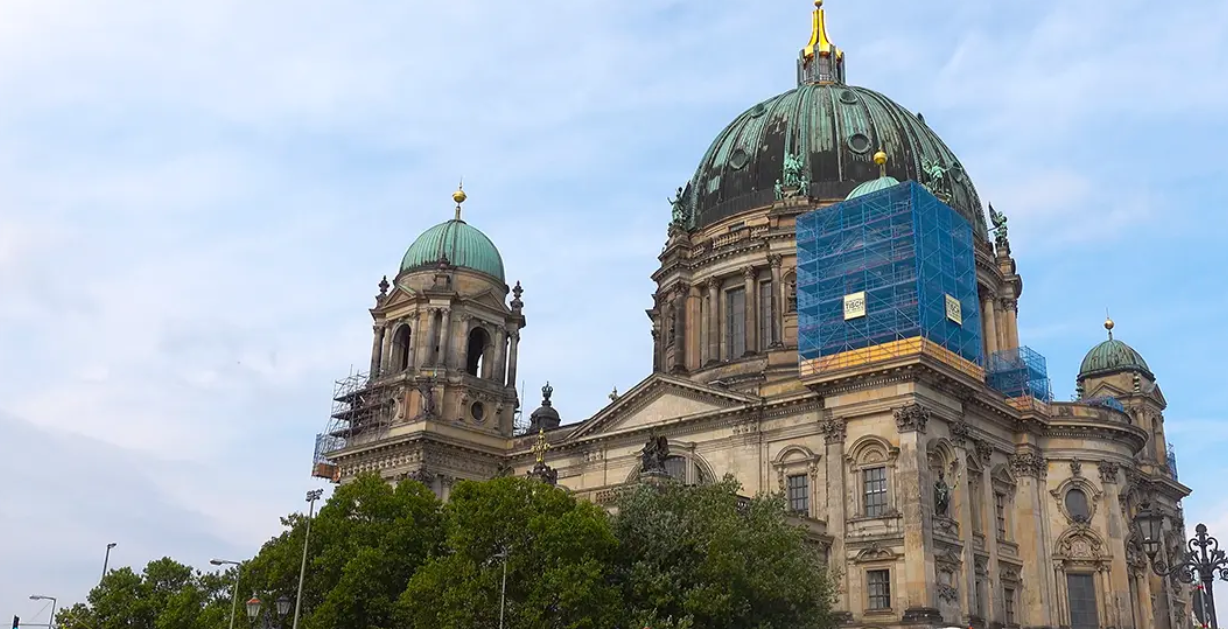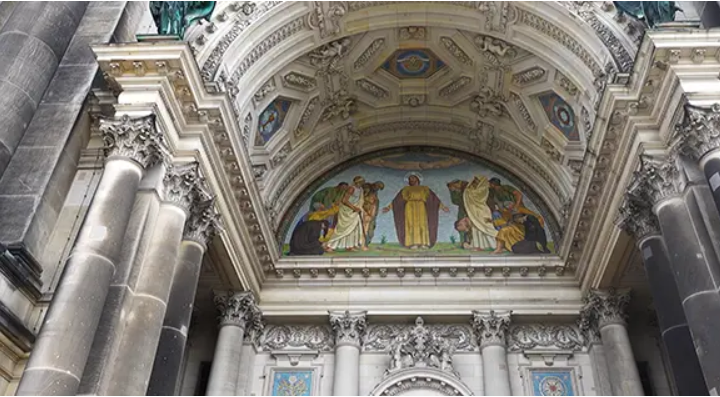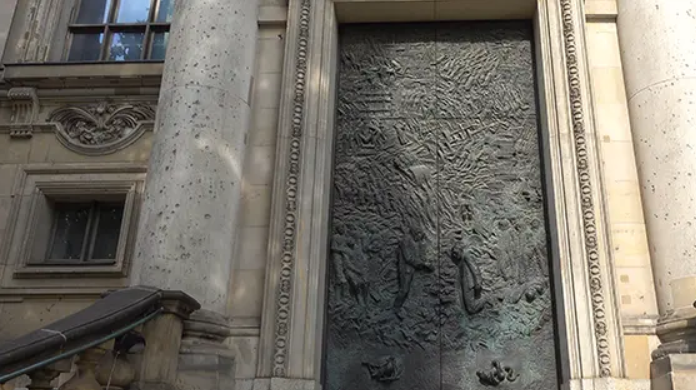One of the most important dynastic burial sites in Europe
Address: Berlin Cathedral, Karl-Liebknecht-Straße 1, 10178 Berlin | Built: 1894 to 1905 | Architectural style: Neo-Baroque & Neo-Renaissance | Height: 98 m
The Berlin Cathedral is undoubtedly one of the most beautiful churches in Berlin and should not be missed on any sightseeing tour of the city. Its unique architecture and rich decorations, both inside and out, are impressive. A magnificent view of Berlin Mitte, the Nikolaiviertel, the Spree River, the Lustgarten, and Museum Island can be enjoyed by climbing to the impressive dome. The church, where the baptism and marriage took place, houses the Cathedral Museum, the Hohenzollern Crypt, and the impressive Imperial Staircase, which never fail to amaze visitors.
Directions and location of this Berlin landmark
The Berlin Cathedral stands in the heart of Berlin’s historic center, at the entrance to Museum Island. This dominant building, with its striking architecture, is a unique monument in Berlin’s architectural history. The cathedral is framed by Am Lustgarten, the park of the same name, the Spree, Friedrichstraße, and Karl-Liebknecht-Straße. Anyone using the Friedrichbrücke or Karl-Liebknecht-Brücke to reach Museum Island will immediately see the ornate 19th-century building.
You are currently viewing placeholder content from OpenStreetMap. To access the actual content, click the button below. Please note that data will be shared with third parties in the process.
Opening Hours and Tours
The Berlin Cathedral can be viewed from the outside at any time. This monument is particularly impressive in the dark, when it is bathed in impressive light by large spotlights. Those wishing to enter the Upper Parish Church and the Cathedral are bound by specific opening hours. Tours are not possible during events and services. The Berlin Cathedral and the dome are open to visitors on the following days:
Berlin Cathedral Opening Hours
Monday to Saturday from 10 a.m. to 5 p.m.
Sunday from 12 p.m. to 5 p.m.
An overview of the dates for cathedral tours, devotions, prayers, and other events can be found on the website https://www.berlinerdom.de/termine/.
Note: Wheelchair users and people with walking difficulties should use the entrance to the Berlin Cathedral to the left of the main portal. This is barrier-free and allows unhindered entry.

Berlin Cathedral Admission Prices
A ticket is required to visit the Berlin Cathedral, the Preaching Church, the Baptismal Chapel, and the Wedding Chapel, and to climb the dome. This ticket cannot be purchased on-site with cash, but only online at https://www.berlinerdom.de/tickets.
Berlin Cathedral Admission Prices
Single Ticket
€10.00
Single Reduced Ticket
€7.50
Single Ticket with Berlin Welcome Card
€7.00
Family Ticket (1 adult + up to 3 children)
€10.00
Family Ticket (1 adult + up to 3 children) Reduced Ticket
€7.50
Guided Tours of Berlin Cathedral
Various guided tours are offered by Berlin Cathedral itself. A 20-minute tour, known as a site tour, is included in the ticket price. While visitors sit in the pews, they are provided with a wealth of information and interesting facts about Berlin Cathedral.
These tours are usually conducted by trained cathedral guides on Fridays, Saturdays, and Sundays around noon. Occasionally, tours may be canceled due to events, rehearsals, or construction work.
Discovering Berlin Cathedral on a group tour means you will gain more background information about the building and its history. Special organ and crypt tours are also offered. A special organ tour is available in conjunction with an organ concert on the Imperial Gallery.
Berlin Cathedral also offers exclusive tours and tours for the visually impaired and blind. During the latter tour, participants have the opportunity to explore some of the richly decorated forms and materials with their own hands, giving them a glimpse of the magnificent aura of the Berlin Cathedral.
Those who don’t want to take a guided tour can normally use the audio guides, although these are currently unavailable. The audiovisual, multilingual tour system from antenna international is a convenient way to explore the Berlin Cathedral independently.
FAQ – Frequently Asked Questions about the Berlin Cathedral
How big is the Berlin Cathedral?
Today’s Berlin Cathedral is 98 meters high and 90 meters long, after the monumental church was demolished. The building was originally 114 meters high, 73 meters wide, and 114 meters long.
When was the Berlin Cathedral built?
The Berlin Cathedral was built between 1894 and 1905 in the Neo-Renaissance and Neo-Baroque styles. It replaced an older cathedral from the 18th century and was designed as the main church of the Protestant congregation in Prussia.
Is the Berlin Cathedral a Protestant or Catholic church?
The Berlin Cathedral is a Protestant church and serves as the bishopric of the Evangelical Church of Berlin-Brandenburg-Silesian Upper Lusatia. It was designed as the main church of the Protestant congregation in Prussia and is an important religious and cultural center in Berlin. Although the cathedral is a Protestant church, it occasionally hosts ecumenical events and services of various denominations.
Can one attend services at Berlin Cathedral?
Yes, Protestant services can be attended regularly at Berlin Cathedral. These take place in the impressive main church and are open to the public. In addition, ecumenical events and special liturgical celebrations are held at Berlin Cathedral.
What coffins are located in Berlin Cathedral?
The Berlin Cathedral contains the royal tombs of the Prussian kings and emperors, including the tomb of Frederick I and Sophie Charlotte, the first Prussian royal couple. Also located here are the tombs of Emperor Wilhelm I, Emperor Frederick III, and Empress Victoria, as well as other members of the Prussian royal family.
Berlin Cathedral – Special Features and Interesting Facts
The magnificent Berlin Cathedral, located in the heart of the German capital, is visible from afar with its unique dome. Its ornate architecture immediately catches the eye. Upon entering, visitors are greeted by an artfully designed and lavishly decorated interior. It was once considered a stage for the Hohenzollern family, whose residence was the city palace on the other bank of the Spree.
The exterior of the Berlin Cathedral is dominated by its monumental dome and four towers. The building’s opulent architecture originates from the Italian High Renaissance and shows clear influences from the Baroque period. The interior echoes the exuberant architecture common in monumental buildings in the late 19th century.
There are 270 steps to climb to the top of the dome and view Berlin Mitte from above. The Imperial Staircase, with its opulent decorations, even has an elevator. In 1905, the technology-loving emperor had it built by a company in America. The staircase and elevator are accessible to visitors only on very special occasions.
The Hohenzollern Crypt houses around 100 stone sarcophagi, some ornate, some simple, spanning around five centuries. Among them are the coffins of Queen Sophie Charlotte and Frederick I. There is no burial site for Emperor Frederick William II. He found his final resting place in exile in Holland.

Historical Facts and History of Berlin Cathedral
Berlin Cathedral was built for the Hohenzollern monarchy. The church it had previously served as was consecrated in 1790 and was part of the Berlin City Palace. At the beginning of the 19th century, the building was converted into a simple church in the neoclassical style by Schinkel, Berlin’s most important architect.
Tastes had changed significantly at the turn of the century, and Emperor Frederick William II believed that the cathedral had to be larger and more magnificent to properly represent the monarchy. He commissioned Julius Carl Raschdorff to build Berlin Cathedral, which was to be as magnificent as St. Paul’s Cathedral in London and St. Peter’s Basilica in Rome.
The prestigious cathedral in Berlin was consecrated in 1905 and was heavily damaged during World War II. The former GDR did not begin reconstruction until 1975, but this was less than meticulous. Work on Berlin Cathedral was not completed until 1993, four years after the fall of the Berlin Wall. The old dome cross was replaced with a new golden cross in 2008 and can now be found in the cathedral’s cemeteries. More information about the history and heritage can be found at the Berlin Cathedral Building Association.


Bronze “Door of Reconciliation” at the south portal of Berlin Cathedral
Sights and attractions in the immediate vicinity of Berlin Cathedral
In the immediate vicinity of Berlin Cathedral is the famous Lustgarten, which includes a water garden with impressive fountains, jets, and water features. The Lustgarten steps are adorned with a fighting Amazon throwing her spear at a panther.
Directly next to Berlin Cathedral is the Altes Museum (Old Museum), with collections from the Etruscan and Roman periods.
A stroll along the banks of the Spree River reveals other monumental buildings and unique bronze sculptures and statues, such as “Three Girls One Boy” on the embankment wall.
Also worth seeing is the Neue Wache (New Guardhouse). It is a memorial site in the heart of vibrant Berlin, on the magnificent boulevard “Unter den Linden.” There is a statue by Käthe Kollwitz there, depicting a mother marked by pain and suffering, holding her dead son in her arms.
The Humboldt Forum, located on Museum Island, is also interesting. Across an area of 30,000 square meters, visitors can immerse themselves in art, culture, and science. In the lively Ideas Workshop, they can even experience research at the highest level firsthand.
For art and architecture enthusiasts, the Museum Island, with its five world-famous museum buildings from the Prussian era, is an absolute must.
Cafés and Restaurants Near Berlin Cathedral
If you’re looking for a good cup of coffee and a slice of cake after a long tour of Berlin Cathedral, you won’t have to go far. The Cathedral houses the small, cozy Domcafé. If you don’t want to stop there, there are numerous cafés and restaurants nearby that cater to your culinary needs.
Wine & Coffee House
The Wine & Coffee House is located on Karl-Liebknecht-Straße, about 344 meters from Berlin Cathedral. In a charming atmosphere, you can enjoy a delicious breakfast, waffles, aromatic coffee specialties, and delicious wines.
Address: Wine & Coffee House, Karl-Liebknecht-Str. 1
The Greens
Not far from Lustgraten and Berlin Cathedral, “The Greens” at Krögel awaits its guests with special delicacies. The café is a feel-good oasis, offering various teas, coffee specialties, vegan dishes, delicious snacks, and cakes amidst numerous plants.
Address: The Greens, Am Krögel 2 |
Dea Mon
Located on Monbijouplatz, not far from the Berlin Cathedral, Dea Mon is considered a culinary hotspot. In a tasteful, avant-garde interior with an open kitchen, guests are served dishes with European, Korean, and Japanese influences. If you’re looking to try something new and unique, Dea Mon is definitely the place for you.
Address: Dea Mon, Monbijouplatz 11
Restaurant Wilhelm
Restaurant Wilhelm, located right next to the Berlin Cathedral, pursues a culinary concept characterized by local influences. It serves high-quality German-French cuisine, skillfully crafting simple ingredients to create unique delicacies. The tasteful ambiance perfectly complements the experience.
Address: Restaurant Wilhelm, Schlossplatz